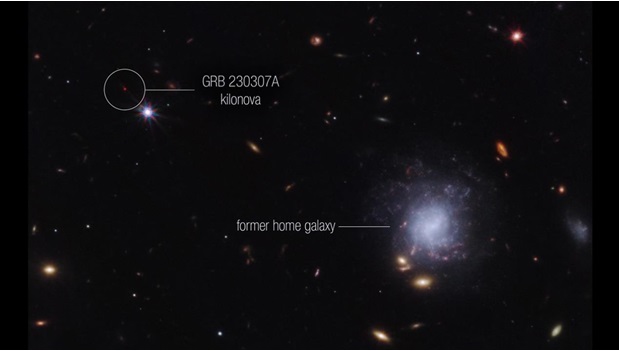Queen’s University Belfast astronomers witness second-brightest gamma-ray burst ever seen
An international team of scientists, including from Queen’s, has observed an exceptionally bright gamma-ray burst (GRB) in the skies – the second-brightest burst witnessed in over 50 years of observations and around 1,000 times brighter than usual.

The remarkably bright and long-lasting burst (over three minutes compared to the usual seconds) was brought about by a ‘kilonova’ – an extremely rare explosion produced by a neutron star merging with either a black hole or with another neutron star.
The sighting of GRB 230307A, to give it its official name, and the identification of the neutron star merger that generated the explosion are detailed in an article published today (Wednesday 25 October 2023) in the journal Nature.
The team was also able to detect the chemical element tellurium – an element rarer than platinum on Earth – in the aftermath of these tumultuous events, providing an important piece of the jigsaw in terms of scientific understanding of heavy elements in the Universe.
“Just over 150 years since Dmitri Mendeleev wrote down the periodic table of elements, we are now finally in the position to start filling in those last blanks of understanding where everything was made, thanks to [the] Webb [telescope],” said Professor Andrew Levan of Radboud University in the Netherlands and the University of Warwick in the UK, lead author of the study.
While neutron star mergers have long been theorized as being the ideal “pressure cookers” to create some of the rarer elements substantially heavier than iron, astronomers have previously encountered a few obstacles in obtaining solid evidence.
The groundbreaking observations were made using multiple space and ground-based telescopes, including NASA’s James Webb Space Telescope, NASA’s Fermi Gamma-ray Space Telescope, and NASA’s Neil Gehrels Swift Observatory. This collaboration allowed scientists to piece together a wealth of information as soon as the burst was first detected, using a combination of satellites and telescopes to track changes as they unfolded.
One of the international team of scientists, Dr Matt Nicholl, from Queen’s University Belfast, said: “The Webb [observatory’s] detection of the kilonova and the presence of tellurium tell the incredible story of how the Universe manufactures heavy elements.
“Two massive stars grow old together in a close orbit around each other, and each eventually undergoes a huge supernova explosion to produce a neutron star or black hole.
“If they manage to stay together, they emit gravitational waves — ripples in the Universe — that shrink the orbit until these remnants collide in one final spectacular explosion that makes a kilonova and a gamma-ray burst.”
Because kilonovae are so rare, it has been challenging for scientists to observe these events. Short GRBs, traditionally thought to be those that last less than two seconds, can be byproducts of these infrequent merger episodes. In contrast, long GRBs may last several minutes and are usually associated with the explosive death of a massive star.
The case of GRB 230307A is particularly remarkable. First detected by NASA’s Fermi Gamma-ray Space Telescope in March 2023, it is the second brightest GRB observed in over 50 years of observations, about 1,000 times brighter than a typical GRB that Fermi [telescope] observes. It also lasted for 200 seconds, placing it firmly in the category of long duration gamma-ray bursts, despite its different origin.
After the first detection, an intensive series of observations from the ground and from space, including with NASA’s Neil Gehrels Swift Observatory, swung into action to pinpoint the source on the sky and track how its brightness changed. These observations in the gamma-ray, X-ray, optical, infrared, and radio showed that the optical/infrared counterpart was faint, evolved quickly, and transitioned from blue to red – the hallmarks of a kilonova.
Scientists expect to find even more kilonovae in the future due to the increasing opportunities to have space and ground-based telescopes work in complementary ways to study changes in the universe. For example, while the Webb telescope can peer deeper into space than ever before, the remarkable field of view of NASA’s upcoming Nancy Grace Roman Space Telescope will enable astronomers to scout where and how frequently these explosions occur.
